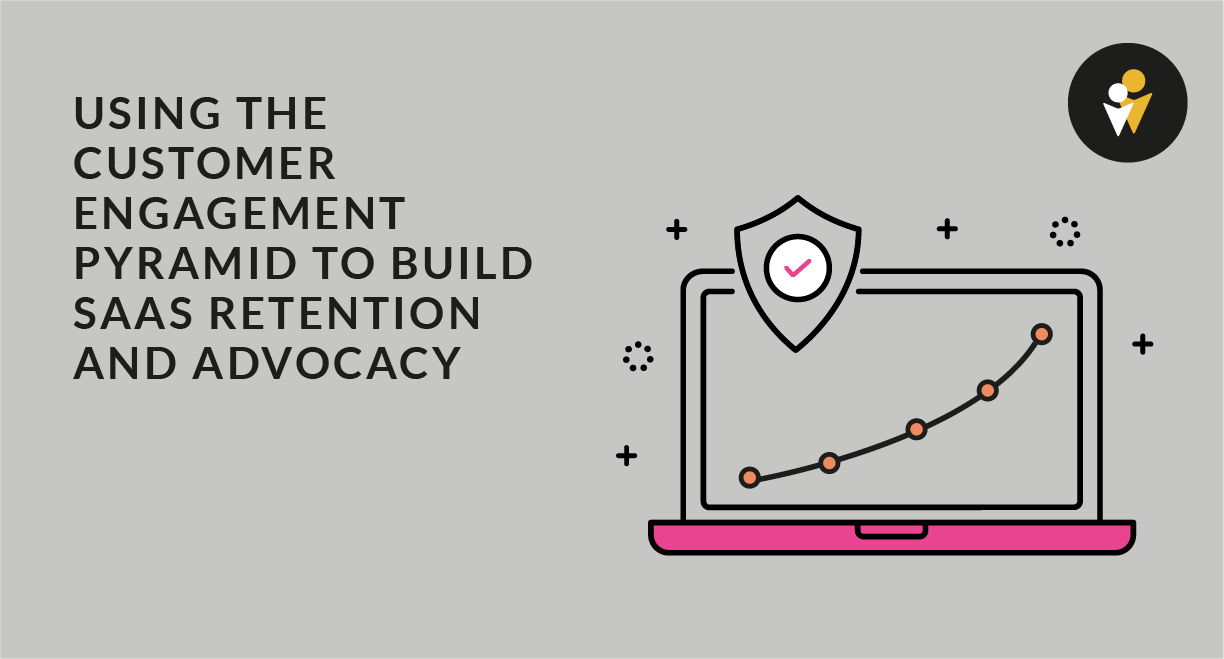For SaaS companies, the most valuable customers aren’t just the ones who renew their subscriptions—they’re the ones who can’t stop talking about your product. These brand advocates actively promote your software to others, driving organic growth and reinforcing your company’s credibility.
Advocacy like this doesn’t happen by accident. It’s the result of intentional strategies that nurture customers at every stage of their journey. The Customer Engagement Pyramid offers a structured way to strengthen these relationships, moving from basic engagement to deep emotional connections that drive retention and advocacy.
In this blog, we’ll explore how SaaS companies can use the Customer Engagement Pyramid to foster stronger relationships, reduce churn, and turn satisfied customers into vocal champions of their brand. Let’s dive in.

Understanding the Customer Engagement Pyramid
The Customer Engagement Pyramid is a powerful framework that breaks down the key stages of customer relationship management into five interconnected levels: Awareness and Acquisition, Activation, Retention, Revenue, and Referral. Each level plays a unique role in guiding customers through their journey, building stronger relationships, and creating brand advocates.
For SaaS companies, this framework offers a roadmap for managing the customer lifecycle—from introducing potential users to your product, to converting them into loyal advocates. The strength of the pyramid lies in its interconnectedness; neglecting one level weakens the entire structure, while mastering each stage ensures a solid foundation for retention and advocacy.
Let’s take a closer look at each level and the strategies that can elevate your SaaS business.
Level 1: Awareness and Acquisition
The foundation of the pyramid begins with awareness—ensuring your target audience knows your product exists—and acquisition, the process of turning awareness into paying customers.
Key Strategies for Awareness and Acquisition:
- Clear Value Proposition: Communicate what makes your SaaS product unique and how it solves customer pain points.
- Effective Messaging: Tailor your messaging to resonate with specific customer segments, using targeted ads, blogs, and case studies.
- Lead Conversion Tactics: Use free trials, demos, or limited-time discounts to turn curious leads into first-time users.
Awareness and acquisition set the tone for the customer journey. Without a strong start, it’s difficult to move users up the pyramid.
Level 2: Activation
Activation is where new users experience the value of your SaaS product for the first time. This stage is critical because it’s where you can win—or lose—a customer within days of signing up.
Key Strategies for Activation:
- Onboarding Excellence: Design an intuitive, step-by-step onboarding process that highlights your product’s core features.
- Early Engagement Goals: Encourage customers to take key actions, like completing their profile or using a standout feature, to realize immediate value.
- Product-Market Fit: Ensure your solution meets customer expectations and provides tangible benefits from the start.
Activation turns one-time users into engaged customers who are more likely to stick around.
Level 3: Retention
Retention is the heart of SaaS success. Keeping customers engaged and satisfied is far more cost-effective than acquiring new ones, making this stage essential for reducing churn and maximizing value.
Key Strategies for Retention:
- Customer Support: Provide exceptional, responsive support that helps users navigate challenges.
- Proactive Communication: Use email marketing workflows, in-app messages, and regular check-ins to keep users informed and engaged.
- Build Relationships: Invest in loyalty programs, personalized content, and feedback loops to show customers they’re valued.
A focus on retention creates the trust and satisfaction needed to transition customers to the next levels of the pyramid.
Level 4: Revenue
Revenue isn’t just about increasing sales; it’s about deepening relationships and creating mutual value. This stage involves expanding the customer relationship through upselling, cross-selling, and delivering additional value.
Key Strategies for Revenue:
- Upselling and Cross-Selling: Offer complementary features or premium plans tailored to customer needs.
- Expand Use Cases: Highlight ways customers can use your product to solve additional challenges or meet new goals.
- Track CLTV: Focus on metrics like Customer Lifetime Value (CLTV) to measure and maximize the financial impact of each relationship.
Revenue strategies ensure customers continue to see your product as an integral part of their success.
Level 5: Referral
The pinnacle of the pyramid is referral, where your satisfied, retained customers become vocal advocates who recommend your SaaS product to others. Advocacy drives organic growth and is a testament to the strength of your customer relationships.
Key Strategies for Referral:
- Create a Referral Program: Incentivize referrals with discounts, credits, or exclusive perks.
- Recognize Advocates: Publicly acknowledge and reward loyal customers who champion your brand.
- Share Success Stories: Amplify customer testimonials and case studies to inspire others to join your community.
Referrals close the loop of the customer lifecycle, feeding new customers into the awareness stage and strengthening your pyramid.

Nurturing Customers into Advocates with the Customer Engagement Pyramid
Creating brand advocates starts with delivering an exceptional customer experience. In the SaaS world, customer advocacy is the culmination of thoughtful relationship management at every stage of the Customer Engagement Pyramid. Each level builds the foundation for deeper loyalty, trust, and ultimately, advocacy. When customers feel seen, heard, and supported, they’re far more likely to champion your brand.
The Connection Between Customer Experience and Advocacy
Advocacy doesn’t happen in a vacuum—it’s the result of a seamless and satisfying journey. From the first impression of your SaaS product to ongoing support and communication, every interaction with your business contributes to the customer experience. Positive experiences drive loyalty, while frustration can lead to churn. By managing each level of the Customer Engagement Pyramid, you can ensure customers stay engaged and feel valued, making them more likely to become advocates.
Building a Strong Customer Community
Advocates thrive in communities where their voices are valued and amplified. A robust customer community doesn’t just strengthen relationships; it also fosters a sense of belonging and ownership in your brand. This could mean hosting user forums, running social media groups, or offering opportunities for customers to connect and share their experiences. By cultivating this sense of community, SaaS businesses can create an environment where advocacy naturally flourishes.
Tactics for Empowering Customers to Become Brand Ambassadors
Turning satisfied customers into enthusiastic advocates requires a strategic approach across every stage of the Customer Engagement Pyramid. Each level—Awareness, Activation, Retention, Revenue, and Referral—plays a role in building trust, loyalty, and engagement. To foster advocacy, SaaS companies should focus on these key strategies:
- Prioritize Trust at Every Touchpoint: From transparent messaging during acquisition to reliable support during retention, consistently meeting customer expectations builds a strong foundation for advocacy.
- Create Personalized Experiences: Tailor communications, onboarding, and upselling opportunities to individual customer needs to show you’re invested in their success.
- Engage Customers Actively: Encourage customers to participate in your community, whether through feedback loops, beta testing, or content contributions like testimonials and case studies.
- Make Advocacy Easy and Rewarding: Implement a referral program with clear benefits, recognize loyal customers publicly, and give them the tools to share your product effortlessly.
By viewing the Customer Engagement Pyramid as a cohesive strategy rather than isolated steps, SaaS companies can seamlessly guide customers from first-time users to enthusiastic brand ambassadors who fuel growth.
Measuring and Optimizing Advocacy Efforts
Building a network of brand advocates is a rewarding outcome, but how do you know your efforts are paying off? Measuring and optimizing advocacy efforts is essential for maintaining momentum and ensuring your strategies deliver maximum ROI. By tracking the right metrics and continuously refining your approach, you can create a self-sustaining cycle of engagement, retention, and advocacy.
Key Metrics to Track Brand Advocacy
To evaluate the effectiveness of your advocacy efforts, start by tracking these essential metrics:
- Net Promoter Score (NPS): This is one of the most reliable indicators of advocacy. A high NPS shows that customers are not only satisfied but also willing to recommend your SaaS product to others.
- Referral Rate: Monitor the percentage of new customers coming from referrals. This directly reflects how effective your advocates are in promoting your product.
- Social Shares and Mentions: Advocacy often shows up on social media. Track brand mentions, shares, and engagement to gauge how often your advocates are spreading the word.
- Customer Lifetime Value (CLTV): Advocacy often correlates with high CLTV. If your advocates are sticking around and upgrading their plans, you’re on the right track.
- Advocate Participation: Measure how many of your users engage in advocacy programs, such as referral incentives or community activities.
Analyzing Advocacy Data to Measure ROI
Advocacy efforts should ultimately contribute to your SaaS company’s bottom line. Use your data to calculate the return on investment (ROI) for your strategies. For example:
- Track Conversion Rates: For referral programs, measure how many referred customers convert to paying users and compare this with acquisition costs.
- Assess Advocacy Impact on Growth: Analyze how brand mentions, reviews, and testimonials impact sales, web traffic, and new customer sign-ups.
- Monitor Customer Retention Rates: Advocates are often retained customers. Look for trends linking advocacy behaviors to extended subscription lengths and increased revenue.
Using these insights, you can identify which advocacy strategies are delivering results and which may need adjustment.
Continuous Optimization and Iteration
Advocacy isn’t a one-and-done initiative; it requires constant attention and refinement. Strategies that work at one level of the Customer Engagement Pyramid might need tweaking as your SaaS product evolves.
- Refine Each Level: Look for gaps or friction points in the customer journey. For example, if referrals are low despite a strong NPS, revisit your referral program to ensure it’s easy and rewarding for customers to participate.
- Leverage Feedback: Use NPS surveys, customer feedback, and advocate testimonials to refine your messaging, product features, and engagement tactics.
- Test New Approaches: Experiment with new incentives, community-building initiatives, or recognition strategies to see what resonates most with your advocates.
By taking an iterative approach, SaaS companies can adapt to customer needs, stay ahead of industry trends, and maintain a steady pipeline of loyal advocates.
Measuring and optimizing advocacy efforts isn’t just about tracking metrics; it’s about understanding what drives customer loyalty and amplifying those efforts. With the right metrics, analysis, and continuous improvement, you can transform advocacy into a powerful growth engine for your SaaS business.
Leveraging the Customer Engagement Pyramid for SaaS Retention and Advocacy Success
The Customer Engagement Pyramid is more than just a framework—it’s a roadmap for turning customers into loyal advocates who drive long-term success for your SaaS business. By focusing on each level of the pyramid, from awareness to referral, you can create a seamless customer experience that builds trust, encourages engagement, and strengthens relationships.
A strong advocacy program is one of the most valuable assets a SaaS business can have. Advocates do more than retain their subscriptions—they amplify your brand, attract new customers, and create a sense of community that fosters even greater loyalty. Advocacy isn’t just a byproduct of customer satisfaction; it’s the result of intentional efforts to nurture, engage, and empower customers at every stage of their journey.
The strategies outlined in this blog aren’t abstract ideas—they’re actionable steps your SaaS company can take today to begin transforming customers into advocates. Whether you’re refining your onboarding process, optimizing retention efforts, or building a referral program, each improvement brings you closer to creating a base of enthusiastic customers who champion your brand.
The power of advocacy lies in its ability to grow your business organically, sustainably, and with the credibility that only comes from trusted recommendations. By leveraging the Customer Engagement Pyramid, you can unlock that power and set your SaaS business on a path to retention and advocacy success. It’s time to take the next step—start building your pyramid today.













